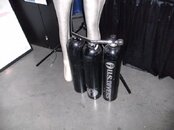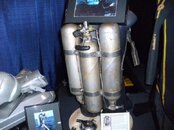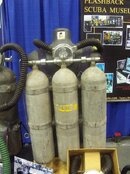I own a UDS-1 and have written extensively about it here.
It was manufactured with two problems:
1. It's harness was a combination of European and USA designs. It had the European shoulder straps, which go way down on the unit, and it had a waist strap originating from where the lower attachment for the shoulder strap. Unfortunately, this placed the unit's waist strap below the hips, or the shoulder straps too tight.
2. The unit's buoyancy was such that the top of the unit came away from the diver's back (valves on the bottom of the unit) and caught a lot of water. This caused this "streamlined" unit to act anything but streamlined.
These two engineering design problems were overcome in my unit by not using the waist strap (pictured is the unit hooked up to my Para-Sea BC with hip connectors for the scuba), and by weighting the top of the unit by about six pounds. Then, you had a dream unit. The openings were larger than any unit I know of, so the air flow was almost effortless even at very low pressures.
Unfortunately, it still has problems and is sitting disassembled in my garage right now. The problems are that the filler hose attachment broke, and I need to rig up a better means of filling it. But more importantly, the cylinders are one-of-a-kind, with a one-inch opening instead of a 3/4 inch opening. Because it is an aluminum tank, no one currently will hydro test these cylinders as the eddie-current test apparatus apparently does not exist for these one-inch opening cylinders. The hydro facility my LDS uses declined to test the cylinders. I'm currently looking at options for getting the hydro test accomplished on them.
John




